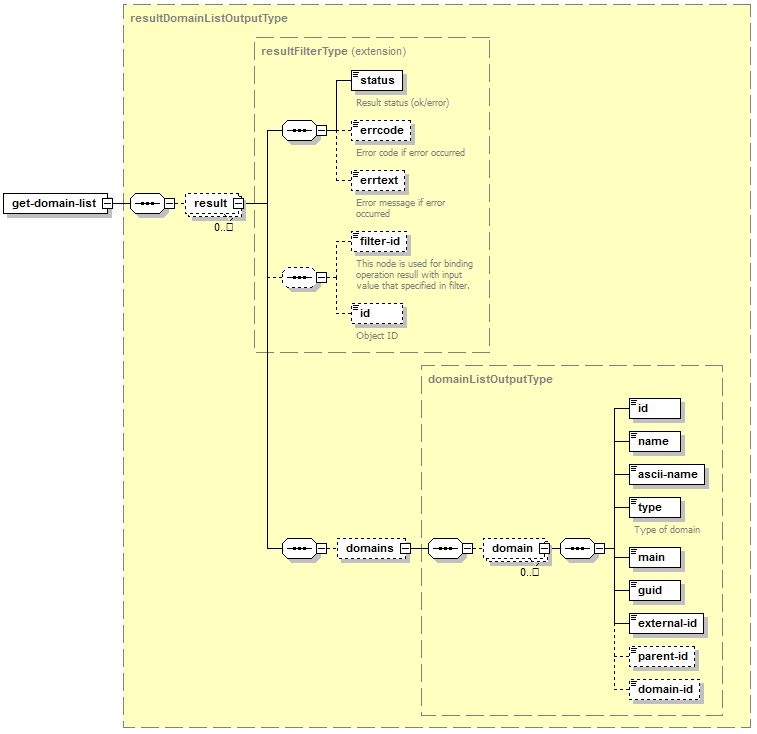Retrieving the List of Customer’s Domains
The get-domain-list operation is used to retrieve the list of customer’s domains, subdomains, and domain aliases.
Request Packet Structure
A request XML packet includes the get-domain-list node:
<packet>
<customer>
<get-domain-list>
...
</get-domain-list>
</customer>
</packet>
The get-domain-list node is nested within the ClientTypeRequest
complex type (client_input.xsd). Its graphical representation is as
follows:

Note: The interactive schema navigator for all request packets is available here: http://plesk.github.io/api-schemas/1.6.8.0/agent_input.svg.
- The filter node is required. It specifies the filtering rule. Data type: clientSelectionFilterType. For more information on filters, refer to the Available Filters section.
Response Packet Structure
The get-domain-list node of the response packet is structured as follows:

Note: The interactive schema navigator for all response packets is available here: http://plesk.github.io/api-schemas/1.6.8.0/agent_output.svg.
The result node wraps the response retrieved from the server. Data
type: resultFilterType (common.xsd).
-
result, required. It wraps the response got from the server.
Data type: resultFilterType (
common.xsd). - status, required. It specifies the execution status of the operation. Data type: string. Allowed values: ok | error.
- errcode, optional. It returns the error code when the operation fails. Data type: unsignedInt.
- errtext, optional. It returns the error message if the operation fails. Data type: string.
- filter-id, optional. It returns the parameter by which the reseller account was filtered by in the request packet. Data type: anySimple.
-
id, optional. It returns the identifier of the reseller account
for which the applications filter was turned on. Data type: id_type
(
common.xsd).
The information about the domains is held by the domain node, which
is presented by complex type domainListOutputType
(domain_list.xsd). The node is structured as follows:
- The id node is required. It holds the ID of the domain. Data type: id_type.
- The name node is required. It holds the domain name. Data type: string.
- The ascii-name node is required. It holds the domain name in ASCII characters. Data type: string.
- The type node is required. It holds the domain type (domain, subdomain, alias). Data type: string.
- The main node is required. It indicates whether the domain is the main domain under a subscription. Data type: boolean.
- The guid node is required. It holds the unique identifier of the domain. Data type: string.
- The external-id node is required. It holds the identifier of the domain in an external system. Data type: string.
- The parent-id node is optional. It holds the ID of the parent domain to which the subdomain belongs. Data type: id_type.
- The domain-id node is optional. It holds the ID of the domain to which the domain alias is related. Data type: id_type.
Samples
The request packet that retrieves information about customer’s domains can look as follows:
<packet>
<customer>
<get-domain-list>
<filter>
<id>1</id>
</filter>
</get-domain-list>
</customer>
</packet>
Response:
<packet>
<customer>
<get-domain-list>
<result>
<status>ok</status>
<filter-id>31</filter-id>
<id>31</id>
<domains>
<domain>
<id>37</id>
<name>jsmith111.com</name>
<ascii-name>jsmith111.com</ascii-name>
<type>domain</type>
<main>true</main>
<guid>9a82a132-601a-4cd0-9f81-4b4321eedfed</guid>
<external-id/>
</domain>
<domain>
<id>39</id>
<name>sub1.jsmith111.com</name>
<ascii-name>sub1.jsmith111.com</ascii-name>
<type>subdomain</type>
<main>false</main>
<guid>6d4624ef-3acb-42da-89db-be18d3d72aa8</guid>
<external-id/>
<parent-id>37</parent-id>
</domain>
<domain>
<id>40</id>
<name>sub2.jsmith111.com</name>
<ascii-name>sub2.jsmith111.com</ascii-name>
<type>subdomain</type>
<main>false</main>
<guid>f827f280-c850-4737-8029-16a4ba2a732b</guid>
<external-id/>
<parent-id>37</parent-id>
</domain>
<domain>
<id>6</id>
<name>aliassmith.com</name>
<ascii-name>aliassmith.com</ascii-name>
<type>alias</type>
<main>false</main>
<guid>9a82a132-601a-4cd0-9f81-4b4321eedfed</guid>
<external-id/>
<domain-id>37</domain-id>
</domain>
<domain>
<id>38</id>
<name>adddom1.com</name>
<ascii-name>adddom1.com</ascii-name>
<type>domain</type>
<main>false</main>
<guid>49344458-75c7-4dad-8439-d74e01ce6bb8</guid>
<external-id/>
</domain>
</domains>
</result>
</get-domain-list>
</customer>
</packet>